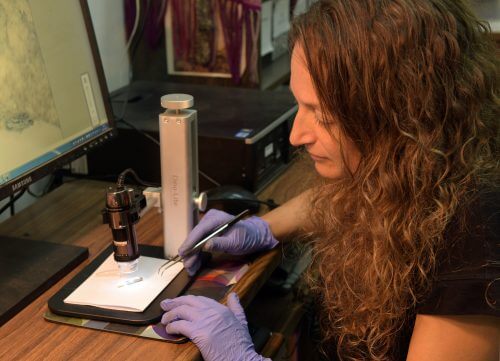According to the tests that were done and the quality of the fibers of the wick, the inhabitants of Shebata during the Byzantine period bought lower quality linen for making the wicks, while they left the high quality linen for the clothing industry. "The rare wick that was tested belongs to the type of glass candle typical of the Byzantine period - a kind of cup or glass bowl that was filled with oil and enabled, through the linen wick, a long illumination even in the hours of darkness"

A new study conducted by the Antiquities Authority identified a single wick of its kind that was used to light light oil candles, dating back to the Byzantine period - about 1500 years ago. Despite its small size, its importance is great because it was definitely identified as a wick, while the number of known wicks is very few.
The wick was tested for the first time as part of a comprehensive study conducted by the University of Haifa, led by Prof. Guy Bar Oz and Dr. Yotam Teper, in the Byzantine settlements in the Negev. As part of the research, Dr. Teper found unpublished findings from the excavations of the American expedition led by Colt, which were conducted in the 30s in Shveta in the Negev. The wick was handed over for testing at the Antiquities Authority laboratories.
According to Dr. Naama Soknik from the Antiquities Authority, who studied the wick, "it seems that the rare find was preserved thanks to the dry climate that prevails in the Negev. The oil candles played a central role in daily life in antiquity and enabled the illumination of houses and public buildings even in the hours of darkness. The candles, made of clay or glass, are often found in archaeological excavations, but it is rare to find wicks from antiquity. The reasons for this probably lie in the fact that it is an object made of plant fibers, which usually breaks down quickly and disappears in the ground, and also in the fact that it is an object of small dimensions, which for the most part was consumed by fire."
The wick was found inside its wick house - a kind of small tube made of copper, inside which the wick was placed when it was lit. A macroscopic examination conducted by Dr. Suknik indicated that the wick was made from flax fibers produced from the flax plant, known from the textile and clothing industry, and that its fibers were suitable, among other things, for burning a candle and spreading light.
"In the chapter devoted to the subject in the Shabbat tractate of the Mishnah, called "Bama Madalikin", burning materials and types of wicks that can be used to light a Shabbat candle were discussed. There, too, linen is mentioned as a high-quality raw material for making wicks, since it burns long and beautifully," says Dr. Suknik. "Other wicks mentioned in the Mishnah were made from different fibers that were of poor quality and were therefore rejected, among which are mentioned the fibers produced from the desert wick plant, which grows to this day in the Dead Sea region. It seems that the residents of Shveta also chose to illuminate their public buildings with flax, because the flax plant does not grow in the Negev and it is likely that it reached the place from the more northern part of the country, through trade routes. According to the tests that were done and the quality of the fibers of the wick, Dr. Suknik assumes that the residents of Shebata during the Byzantine period bought lower quality linen for the preparation of the wicks, while they left the high quality linen for the clothing industry. "The rare wick that was tested belongs to the type of glass candle typical of the Byzantine period - a kind of cup or glass bowl that was filled with oil and enabled, through the linen wick, a long illumination even in the hours of darkness."
Despite the tiny size of the find from Shvata, which does not exceed a few centimeters in length, it sheds light on one of the essential and common objects in antiquity, which almost disappeared from the world, but survived in Shvata." says Dr. Suknik.
The wick, and other objects from the Colt excavations in Shveta, will be displayed starting 24/1/2019 in an exhibition at the Hecht Museum in Haifa.
